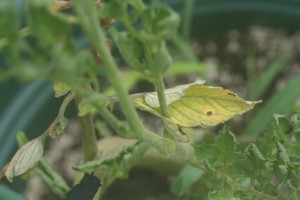What Is Wrong with My Tomatoes?

Like a lot of northern gardeners, my tomatoes were looking fantastic up until about a week ago. The plants were large, flowers and fruit plentiful and everything looking green and gorgeous. Then, we had a heavy down pour and another, and after the rain came heat and humidity. And, now, I’m wondering what is wrong with my tomatoes?
Here are a few possibilities:
Early blight is a common disease of tomatoes in late July and August. It is primarily a disease of the leaves, though fruit can be infected. In addition, when the leaves completely die back, the fruit may suffer from sun scald.
Early blight is the result of two fungi that spend the winter in soil or on spent plants from the previous year. The disease expresses itself first as small dark spots on leaves, which eventually yellow and turn brown. There isn’t much you can do about this year’s crop — but don’t give up on it. You may still harvest many delicious fruits even when the foliage looks terrible.
After the season is over, remove the diseased foliage and throw it away. If you are growing tomatoes in the ground (rather than in containers), rotate a different crop into that space next year, such as lettuce or broccoli.
Another possibility is Septoria leaf spot, a disease that seems to emerge in hot, humid conditions when plants do not have enough air circulation around them. This also starts with lesions on the leaves, which tend to spread from the bottom of the plant up. If you look closely, you will see a tiny black or brown spot within each lesion. Septoria leaf spot does not effect fruit, so continue to harvest and enjoy the tomatoes you have. To avoid the disease, water in the morning and at the base of plants. (The fungus is often splashed onto plants during heavy rains or watering. Stake plants up and do what you can to promote air circulation.
Since I grow most of my tomatoes in containers, I spread the containers apart to give each plant more air. After the season is over, dispose of the plant debris and rotate crops.
We’ve posted before about tomato diseases here and here. For the rundown on a variety of other tomato problems, check out our Plant Health column from the July/August issue of Northern Gardener.
—Mary Lahr Schier

Great info, I noticed some yellowing lower leaves on a few of my tomatoes, but just the ones growing in the back garden. The tomatoes growing in a new garden area snow no signs of yellowing yet.
Hi Mary, I’ve also noticed those yellow spots on our tomatoes but no real loss yet here in Bucks County PA. We are entering another week of 90 plus with no measurable rain forecasted. Keeping our fingers crossed.